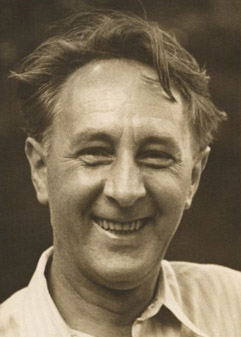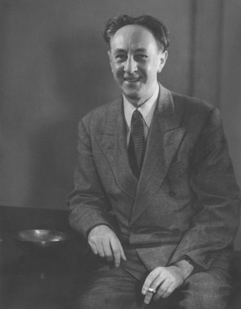Meet … Czech composer Bohuslav Martinů

Bohuslav Martinů
(*8. 12. 1890 – 28. 8. 1959)
Czech composer Bohuslav Martinů was born on 8th December 1890 in Polička. His father Ferdinand, a shoemaker, served as fire watchman, and the family lived in the tower of the St. Jacob Church. He studied violin, piano and organ at the Prague Conservatory from 1906, but he was expelled in 1910 for “incorrigible negligence”. He works as a composer, first consultations with Josef Suk (1874 – 1935).The First World War breaks out in 1914, Martinů is excused from obligatory military service. He begins playing occasionally as an auxiliary violinist in the Czech Philharmonic. In the summer 1916 he returns to Polička teaching violin. As World War I drew to a close, and Czechoslovakia declared an independent republic, Martinů composed a celebratory cantata Česká rapsodie (“Czech Rhapsody”), which was premiered by the Czech Philharmonic in 1919 to great acclaim. As a violinist, he toured Europe with the National Theatre Orchestra, and became a full member of the Czech Philharmonic Orchestra in 1920 (playing second violin, third stand), when he moved back to Prague. He also began formal composition study under Josef Suk for one year (before his departure to France).Martinů departed for Paris in 1923 to study composition with Albert Roussel (1869 – 1937) having received a small scholarship from the Ministry of Education. He lives in Paris, usually spending the summer months in Polička. In 1926, Martinů met Charlotte Quennehen (1894 – 1978), a French seamstress, and they married in 1931.
Martinů is elected a regular member of the Czech Academy of Sciences and Arts and he is published by Leduc. He receives the First Prize from the Elisabeth Sprague Coolidge Foundation in Washington (1932), the Smetana Prize (1933), the Czechoslovak State Prize (1935). In 1937 Martinů meets the Czech composer and conductor Vítězslava Kaprálová (1915 – 1940), but she in 1939 married Jiří Mucha (1915 – 1991). 1938 first commission for Swiss conductor and maecenas Paul Sacher (1906 – 1999).
When the German army approached Paris early in the Second World War, Martinů emigrates via southern France, Spain, and Portugal, having been blacklisted for his connections to the Czech resistance by Gestapo. Finally, he and Charlotte, eventually reached the United States in 1941 with the help of many friends and they settled in New York. In following years he compose his six symphonies, which were performed by all the major US orchestras. In 1943 he composed Memorial to Lidice in remembrance of the village of Lidice that was destroyed by the Nazis in reprisal for the assassination of Reinhard Heydrich in the late spring of 1942. Learns of the death in March 1944 of his mother and follows in shock the political trial of Václav Talich (1883 – 1961).

Since 1946 Martinů teaches at the Berkshire Music School, where he suffers a severe injury whose consequences he will feel for the rest of his life. After the tragic death of Jan Masaryk (1886 – 1948) he abandons the idea of returning to Czechoslovakia and remains in exile. He was named a professor of composition at Princeton University in New Jersey (1948 – 1951), he taught at Mannes College of Music for most of the period from 1948 to 1956.
In 1952 he gains American citizenship. A year later receives a year’s fellowship from the Guggenheim Foundation, leaves the USA, and settles with Charlotte in Nice. From this point on he will live mainly in France, Italy, and Switzerland.
He is elected as a member of the National Institute of Arts and Letters (1955), shortly teaching at the Curtis Institute in Philadelphia and again at the Mannes School of Music in New York until returning to Europe for good in May 1956, when he took up an appointment as composer in residence at the American Academy in Rome. In 1957 again received fellowship from the Guggenheim Foundation. Paul and Maja Sacher invited him to Schönenberg near Basel, and he and Charlotte moved there permanently in September.
In November 1958 his first major health crisis, leading to a stomach operation. Bohuslav Martinů died at a clinic in Liestal, Switzerland, on 28th August 1959. Bohuslav Martinů was buried, as he had wished, in Schönenberg, the estate of Swiss conductor and patron of the arts Paul Sacher. Twenty years late his remains were moved to Polička, where he was born.
His notable students include Alan Hovhaness (1911 – 2000), Herbert Owen Reed (1910 – 2014), Jan Novák (1921 – 1984), Vítězslava Kaprálová (1915 – 1940), Howard Shanet (1918 – 2006), Chou Wen-chung (*1923) and Burt Bacharach (*1928).
In 1975 his wife Charlotte founded the Společnost Bohuslava Martinů (Bohuslav Martinů Society). Also in 1977, she transferred rights to performance and publication of her husband’s works to the newly-founded Nadace Bohuslava Martinů (Bohuslav Martinů Foundation) in Prague, and partly also to the Bohuslav Martinů Stiftung in Basel.
The 55th anniversary of the death of Bohuslav Martinů is commemorated by the Festival Brikcius – the 3rd chamber music concert series at the Stone Bell House & the Year of Czech Music 2014.
For more details about Czech composer Bohuslav Martinů visit websites http://www.Brikcius.com , http://www.Martinu.cz and http://EN.Wikipedia.org/Wiki/Bohuslav_Martinů .
http://www.brikcius.com/News.uk.052.html#Meet

